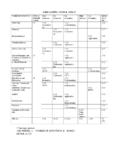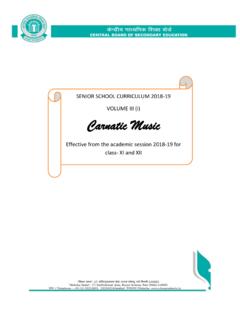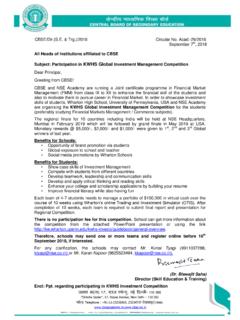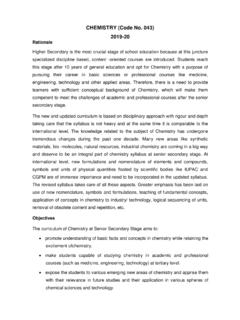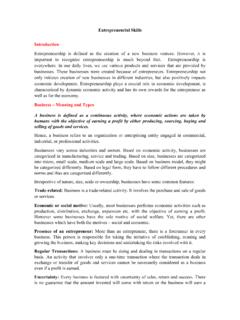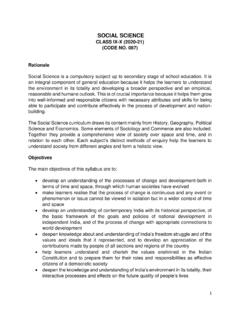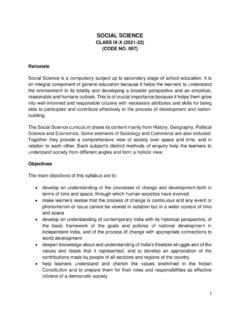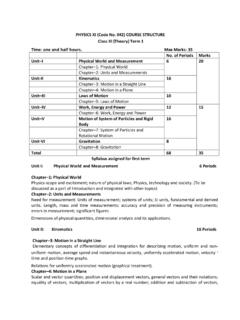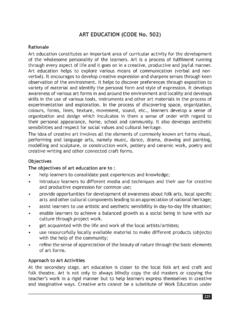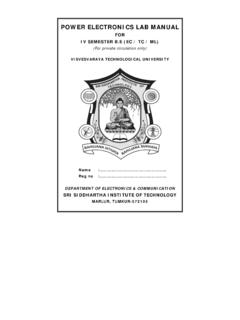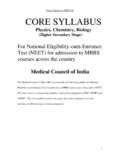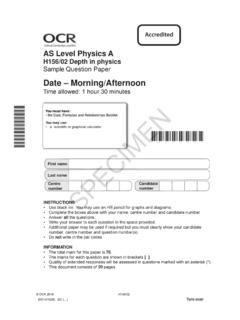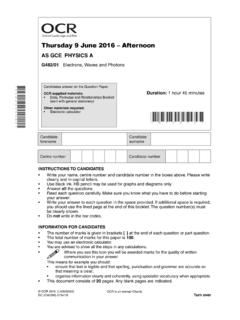Transcription of Sample Question Paper (PHYSICS) CLASS-XII (2017 …
1 1 Sample Question Paper ( physics ) CLASS-XII (2017-18) Time Allowed: 3 Hours Maximum Marks: 70 General Instructions 1. All questions are compulsory. There are 26 questions in all. 2. This Question Paper has five sections: Section A, Section B, Section C, Section D and Section E. 3. Section A contains five questions of one mark each, Section B contains five questions of two marks each, Section C contains twelve questions of three marks each, Section D contains one value based Question of four marks and Section E contains three questions of five marks each. 4. There is no overall choice. However, an internal choice has been provided in one Question of two marks, one Question of three marks and all the three questions of five marks weightage.
2 You have to attempt only one of the choices in such questions. 5. You may use the following values of physical constants wherever necessary. c = 3 X 108 m/s h = X 10-34 Js e = X 10-19 C o = 4 X 10-7 T m A-1 0 = X 10-12 C2 N-1 m-2 = 9 X 109 N m2 C-2 me = X 10-31 kg mass of neutron = X 10-27 kg mass of proton = X 10-27 kg Avogadro s number = X 1023 per gram mole Boltzmann constant = X 10-23 JK-1 2 Section A 1. In the given figure, charge +Q is placed at the centre of a dotted circle. Work done in taking another charge +q from A to B is W1 and from B to C is W2. Which one of the following is correct: W1 > W2, W1=W2 and W1 < W2? 2.
3 Plot a graph showing the variation of current I versus resistance R , connected to a cell of emf E and internal resistance r . 3. State the factors on which the refractive index of a material medium for a given wavelength depends. 4. Sketch the emergent wavefront. 5. In the wave picture of light, intensity of light is determined by square of the amplitude of wave. What determines the intensity of light in the photon picture of light? Section B 6. (a)An alternating voltage E = Eo sin t is applied to a circuit containing a resistor R connected in series with a black box. The current in the circuit is found to be I = Io sin ( t + /4).
4 3 (i) State whether the element in the black box is a capacitor or inductor. (ii) Draw the corresponding phasor diagram and find the impedance in terms of R. 7. The magnetic field in a plane electromagnetic wave is given by: By = 12 10 8 sin ( 107 z + 1015 t) T. Calculate the (i) Energy density associated with the Electromagnetic wave (ii) Speed of the wave 8. A spherical convex surface of radius of curvature 20 cm, made of glass ( = ) is placed in air. Find the position of the image formed, if a point object is placed at 30 cm in front of the convex surface on the principal axis. 9. Name the optoelectronic device used for detecting optical signals and mention the biasing in which it is operated.
5 Draw its I- V characteristics. 10. Give reason, why high frequency carrier waves are needed for effective transmission of information signals. OR What is the range of frequencies used for transmission? State two factors by which the range of TV signals can be increased. Section C 11. (a)How many electrons must be added to one plate and removed from the other so as to store J of energy in a nF parallel plate capacitor? (b) How would you modify this capacitor so that it can store J of energy without changing the charge on its plates? 12. A point charge +Q is placed at the centre O of an uncharged hollow spherical conductor of inner radius a and outer radius b.
6 Find the following: (a) The magnitude and sign of the charge induced on the inner and outer surface of the conducting shell. (b) The magnitude of electric field vector at a distance (i) r = , and (ii) r = 2b, from the centre of the shell. 4 13. The following table gives the length of three copper wires, their diameters, and the applied potential difference across their ends. Arrange the wires in increasing order according to the following: (a) The magnitude of the electric field within them, (b) The drift speed of electrons through them, and (c) The current density within them. Wire no. Length Diameter Potential Difference 1 L 3d V 2 2L d V 3 3L 2d 2V 14.
7 A multirange voltmeter can be constructed by using a galvanometer circuit as shown in the figure. We want to construct a voltmeter that can measure 2V, 20V and 200V using a galvanometer of resistance 10 and that produces maximum deflection for current of 1 mA. Find the value of R1, R2 and R3 that have to be used. 15. Figure shows a metal rod PQ of length l, resting on the smooth horizontal rails AB positioned between the poles of a permanent magnet. The rails, rod and the magnetic field B are in three mutually perpendicular directions. A galvanometer G connects the rails through a key k . Assume the magnetic field to be uniform. Given the resistance of the closed loop containing the rod is R.
8 (i) Suppose K is open and the rod is moved with a speed v in the direction shown. Find the polarity and the magnitude of induced emf. (ii) With K open and the rod moving uniformly, there is no net force on the electrons 5 in the rod PQ even though they do experience magnetic force due to the motion of the rod. Explain. (iii) What is the induced emf in the moving rod if the magnetic field is parallel to the rails instead of being perpendicular? 16. With the help of a diagram, explain the principle of a device which changes a low voltage into a high voltage but does not violate the law of conservation of energy.
9 Give any one reason why the device may not be 100% efficient. 17. In a double slit experiment, the distance between the slits is 3 mm and the slits are 2 m away from the screen. Two interference patterns can be seen on the screen one due to light with wavelength 480 nm, and the other due to light with wavelength 600 nm. What is the separation on the screen between the fifth order bright fringes of the two interference patterns? 18. What do you understand by the statement Light from the sun is unpolarised . Explain how does sunlight gets polarized by the process of scattering? 19. Explain how does (i) photoelectric current and (ii) kinetic energy of the photoelectrons emitted in a photocell vary if the frequency of incident radiation is doubled, but keeping the intensity same?
10 Show the graphical variation in the above two cases. OR (i) Name the experiment which confirms the existence of wave nature of electrons. Derive the expression for de-Broglie wavelength of an electron moving under a potential difference of V volts. (ii) An electron and a proton have the same Kinetic Energy. Which of these particles has the shorter de-Broglie wavelength? 20. The energy levels of an atom of element X are shown in the diagram. Which one of the level transitions will result in the emission of photons of wavelength 620 nm? Support your answer with mathematical calculations. 6 21. Draw a graph showing the variation of binding energy per nucleon versus the mass number A.
